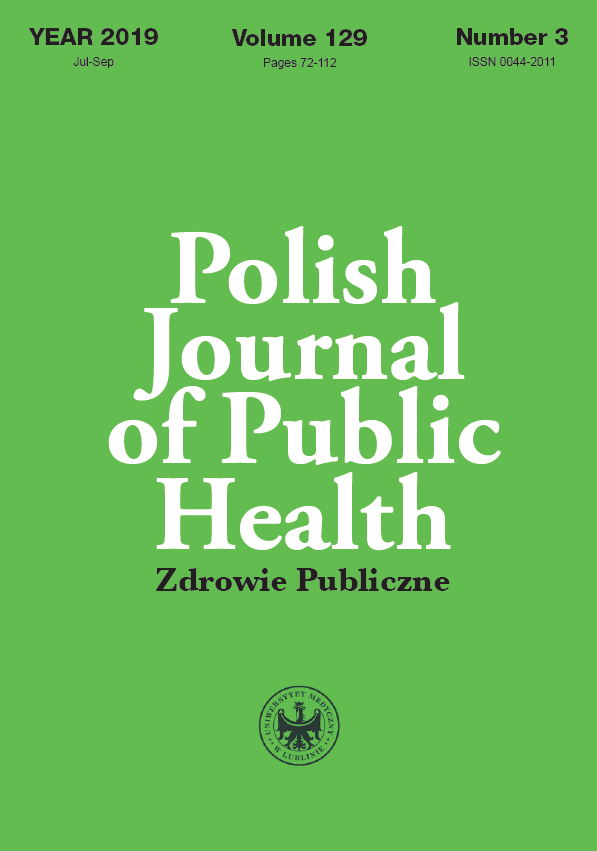Treatment of lesions on the vestibular surfaces of permanent teeth with the use of liquid resin of low viscosity
DOI:
https://doi.org/10.2478/pjph-2019-0025Keywords:
dental materials, resin infiltrant, tooth demineralization/pathologyAbstract
One of the methods of treatment of initial stages of dental caries, lesions characterized by demineralization, and white spots on the vestibular surfaces of permanent teeth, is infiltration with liquid resin of low viscosity. It is a non-invasive method which is worth recommending and popularizing among patients.
On the basis of available literature the therapeutic method of infiltration with liquid resin of low viscosity is presented.
The use of resin of low viscosity allows for obtaining appropriate esthetic and functional appearance of teeth, which is a vital step in improvement of quality of social and professional life of patient.
References
1. Jańczuk Z, Kaczmarek U, Lipski M. Stomatologia zachowawcza z endodoncją. Zarys kliniczny. PZWL, Warszawa 2015.
2. Pels E. Początkowe zmiany demineralizacyjne: przyczyny powstawania, objawy, postępowanie terapeutyczne. Nowa Stomatol. 2016;1:74-8.
3. Boguszewska-Guternbaum H, Turska-Szybka A, Remiszewski A. Fluoroza zębów – opis przypadku. Nowa Stomatologia 2006;2:68-72.
4. Szymańska J, Wójtowicz A, Malm A. Assessment of Candida spp. frequency in the oral cavity ontocenosis of healthy individuals in different age groups. J Pre-Clin Clin Res. 2016;10,2:91-4.
5. Kraus A, Becker K, Świerk M. Demineralizacja szkliwa u pacjentów leczonych stałymi aparatami ortodontycznymi – wstępna ocena skuteczności leczenia metodą infliracji żywicą. Forum Ortod. 2014;10,4:246-54.
6. Kajka-Hawryluk K, Furmaniak K, Gromak-Zaremba J, Szopiński K. Zdjęcia zgryzowo-skrzydłowe we współczesnej stomatologii dziecięcej. Nowa Stomatol. 2015;20,2:73-80.
7. Paris S, Hopfenmuller W, Meyer-Lueckel H. Resin infiltration of caries lesions: An efficacy randomized trial. J Dent Res. 2010;89:823-6.
8. Paris S, Meyer-Lueckel H, Kielbassa AM. Resin infiltration of natural caries lesions. J Dent Res. 2007;86:662-6.
9. Frencken JE, Peters MC, Manton DJ, et al. Minimal intervention dentistry for managing dental caries – a review. Int Dent J. 2012;62:223-43.
10. Kielbassa AM, Müller J, Gernhardt CR. Closing the gap between oral hygiene and minimally invasive dentistry: A review on the resin infiltration technique of incipient (proximal) enamel lesions. Quintessence Int. 2009;40:663-81.
11. Meyer-Lueckel H, Bitter K, Paris S. Randomized controlled clinical trial on proximal caries infiltration: Three-year follow-up. Caries Res. 2012;46:544-8.
12. Paris S, Meyer-Lueckel H, Colfen H, Kielbassa AM. Resin infiltration of artificial enamel caries lesions with experimental light curing resins. Dent Mat J. 2007;26:582-8.
13. Paris S, Schwendicke F, Seddig S, et al. Micro-hardness and minimal loss of enamel lesions after infiltration with various resins: Influence of infiltrant composition and application frequency in vitro. J Dent. 2013;41:543-8.
14. Paris S, Meyer-Lueckel H. Masking of labial enamel white spot lesions by resin infiltration. Quintessence 2009;40:713-8.
15. Piesiak-Pańczyszyn D, Kaczmarek U, Woźniak J. Wpływ wytrawiania powierzchni wczesnej zmiany próchnicowej na proces jej leczenia z użyciem różnych preparatów remineralizacyjnych: badania in vitro. Czas Stomatol. 2005;58,9:620-7.
16. Bille J, Thylstrup A. Radiographic diagnosis and clinical tissue changes in relation to treatment of approximal caries lesions. Caries Res. 1982;16:1-6.
Downloads
Published
Issue
Section
License
Copyright (c) 2020 Polish Journal of Public Health

This work is licensed under a Creative Commons Attribution-NonCommercial-NoDerivatives 3.0 Unported License.


